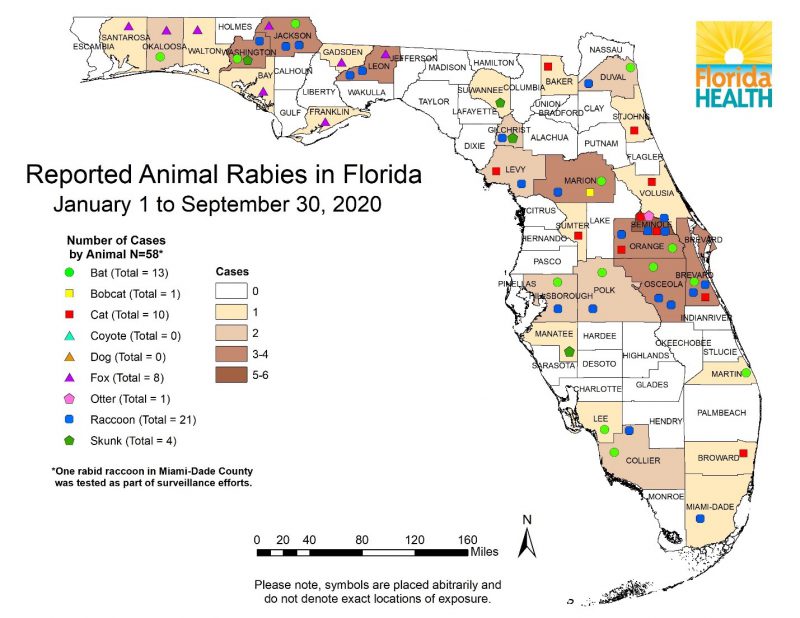Samantha Wisely, UF/IFAS Wildlife Disease Ecology Specialist
–
Florida Rabies Cases in 2020
Rabies is a deadly viral disease that can be prevented, but not cured. In Florida, raccoons and bats are the main source of rabies, but the virus can be transmitted to other wildlife like foxes, skunks, otters and coyotes (Figure 1). In addition, livestock, horses and pets can be infected with rabies. Raccoons, bats, and foxes, have composed the majority of the rabid wildlife in 2020. If infected, all of these animals are capable of transmitting the virus to people. Through the first nine months of 2020, 58 rabid wildlife have been documented by the Florida Department of Health, with 17 of those cases in the Florida Panhandle.

Figure 1. Animals that have tested positive for rabies in Florida in 2020. This map was reproduced with permission from the Florida Department of Health.
–
Rabid Animal Symptoms
Animals infected with rabies act strangely. Wildlife, like raccoons, foxes or coyotes, may lose their fear of humans. Rabid animals can act aggressively or appear confused. Some animals stagger as they lose their ability to move and become paralyzed. They may also drool heavily as they lose the ability to swallow, eat, or drink.
–
Infection of People
People are exposed to the virus when they come into contact with an infected animal’s saliva, which contains the virus. A bite or scratch by an infected animal is considered as exposure to the virus. If a person has a cut on their hand while handling an infected animal, that is also considered an exposure. When infected, livestock and horses often lose their ability to swallow and appear to be choking. Owners commonly become exposed to rabies when they stick their hand in the infected animal’s mouth in an attempt to open the airway.
People also become exposed to the virus when they handle bats without appropriate safety measures. Bats have tiny, sharp teeth that can expose a person to their saliva without leaving a mark. In fact, the Center for Disease Control (CDC) considers a person exposed if they find a bat in their room after being asleep, or if a young child or person that cannot communicate has been in a room unattended with a bat.
If you believe someone has been exposed to a rabid animal, they must receive treatment immediately to prevent becoming infected. Immediately scrub the wound with soap and water for 5-10 minutes. Try and get a complete description of the animal, so that animal control professionals can pick up the animal for quarantine or testing. Seek medical attention from your family doctor or emergency room; professionals will help you determine if you have been exposed and administer post-exposure vaccination and treatment. If you kill the animal, be sure to leave the head intact for testing and take care not to expose yourself to fluids from the animal. Contact your county health department and animal control service to notify them of the exposure and rabid animal.
If your pet is attacked by a rabid animal, do not handle your pet without gloves. Wash the pet’s wound with soap and water to remove saliva and blood, and clean the wound. Secure the animal and keep it from interacting with other people and animals until the Department of Health has determined if the pet was exposed to rabies.
–
How can you prevent being exposed to rabies?
Always vaccinate pets and working animals including barn cats and stock dogs. Unvaccinated dogs and cats are a common route of exposure for people. Vaccines are also available for horses and livestock. In addition to protecting pets and livestock, avoid coming into contact with wildlife. Never feed wildlife or stray animals, and prevent them from being attracted to your home by covering your trash and feeding your pets indoors. Bat-proof the eaves of your house to prevent bats from roosting in your home.

.Figure 2. Vaccinating your livestock, stock dogs, and pets against the rabies virus is the best way to protect your farm workers and family against rabies. Jesse Savelle, UF Beef Teaching Unit. Credit: Josh Wickham, UF/IFAS
–
For more information on rabies, use the following website links:
CDC Rabies website
Florida Department of Health Rabies Website
Contact for your local county health department, if you suspect an animal is infected with rabies.
- How Landowners Can Help Gopher Tortoise Conservation in the Florida Panhandle - August 29, 2025
- Armadillo Biology, Management, and Disease in the Panhandle - February 21, 2025
- Crop Damage from Deer in the Panhandle - August 15, 2024
